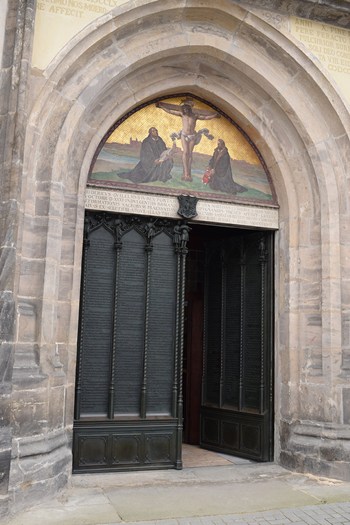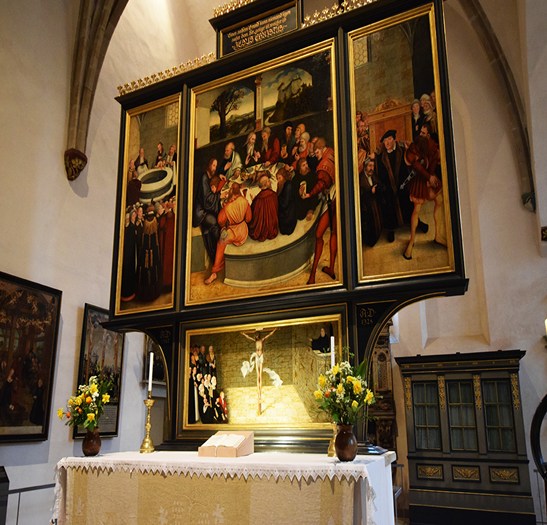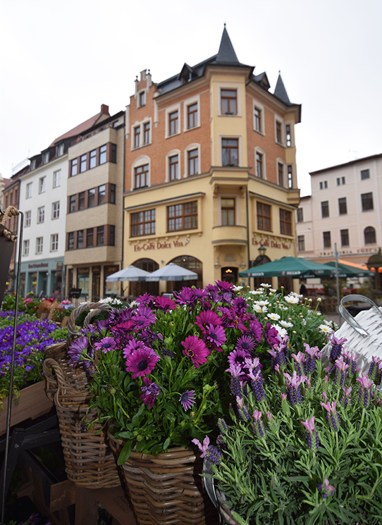WITTENBERG, GERMANY - There’s no doubt Martin Luther’s king of this town. The man who started the Protestant Reformation here in 1517 when he nailed his 95 Theses to the door of All Saints Church (a.k.a. Castle Church) has left his mark everywhere in this handsome city that for 300 years served as capital of Germany’s Saxony-Anhalt state.
So I’m not surprised to see Wittenberg (pronounced Vittenberg) pulling out all the stops as it prepares to welcome the hordes of Protestants expected here in 2017 to help celebrate the 500th anniversary of Luther’s defiant stance against the Roman Catholic Church.
Buildings that played an important role in the Reformation, like Lutherhaus museum where he lived, Wittenberg University where he taught, and Castle Church where Luther’s body lies entombed, have all been restored to their former glory in preparation for the big anniversary.


Left: Portrait of Luther. Right: Doors he pinned his 95 Theses.
One local man tells me: “Our city has never looked better.”
There’s no better proof of that than Collegienstraße, the lovely cobbled street that leads from Lutherhaus to Wittenberg’s impressive main square, where all the buildings and shops have been spruced up - and that includes the house where Philipp Melanchthon, Luther’s main collaborator in the Reformation battle, once lived.
Melanchthon’s narrow home, which features a lovely Amsterdam-style gable, is considered one of Wittenberg’s most beautiful buildings and now serves as a museum honouring his legacy. Built in 1536, Melanchthon lived in the house - one of four UNESCO World Heritage Sites in tiny Wittenberg - until his death in 1560 at 63.
To show how important Melanchthon was to the Reformation movement, a bronze statue of him stands alongside Luther in Wittenberg’s impressive Marktplatz (Market Square) where the town’s historic Town Hall is located.
Wittenberg - the official name is Lutherstadt Wittenberg - looks much different now than it did a few decades ago when it was part of the old East Germany and governed by communists. During that dark era, many of the town’s historic buildings were left to decay. However, after the Berlin Wall fell and Germany was reunified in 1990, the Wittenberg Renaissance began in earnest; accelerated, no doubt, by the 2017 Reformation celebrations.
However, while enjoying a glass of wine at one of the quaint wine bars on Collegienstraße, I can’t help but notice how few young people there are walking the town’s streets - Wittenberg, after all, is home to a campus of the Martin Luther University of Halle-Wittenberg.


Left: Luther statue in main square. Right: City Church where he preached.
“After graduating, most of our young people go to Berlin or other western German cities to find work,” a guide named Oliver Frederic tells me later. “There is little work here in Wittenberg - after the fall of communism our steel mills closed and we have had high unemployment (it hovers around 20 per cent annually) ever since, just like most of eastern Germany.”
Wittenberg’s population of 30,000 is half of what it was during the communist era and Frederic tells me: “about 1,500 people leave our town each year.”
So the construction work surrounding the Reformation celebrations is a welcome relief for this medieval town located on the River Elbe, one of Germany’s most important waterways.
After visiting Lutherhaus, the former Augustinian monastery that first served as Wittenberg’s university (Leucorea) and later was converted into Luther’s home when he married Katharina von Bora, I make my way to Marktplatz, which is bordered by some charming outdoor cafès and dominated by the Rathaus (the Town Hall).
Historic Rathaus is a striking edifice whose orange roof and white exterior make it stand out from the other medieval buildings and churches surrounding it.


Above: Wittenberg was a city in the former East Germany for many years.
Started in 1521, it took 20 years to complete Rathaus and over time architectural additions have changed the building’s original 16th century design. For instance, 30 years ago the portal, balcony and little bell tower were added - its ornate gables were included during the Renaissance.
“The Rathaus is where they used to burn witches,” Frederic informs me as we make our way across the square, which also includes a large fountain (circa 1617) and the early 19th-century bronze statues of Luther and Melanchthon.
On the opposite side of the square we enter the house where one of Germany’s most famous painters, Lucas Cranach the Elder, lived from 1505 to 1547. Cranach the Elder, who also served as Wittenberg’s mayor the year (1543) Rathaus was completed, was court painter to the Duke of Saxony in the time of the Reformation and many of his priceless works feature characters who played important roles in the Protestant uprising.
From the upstairs window of Cranach House - now a museum - I get a great view of the Rathaus, Marktplatz and the two towers of City Church, parts of which date back to 1280. City Church is where Luther was pastor for 36 years and where he gave over 2,000 sermons. It’s also where some of Cranach’s most treasured works now hang above the main alter.
The artifacts on display in Cranach House, which also contains the artist’s studio, fascinate but what really excites visitors is the courtyard behind the home where I find mediaeval dwellings with slanted roofs.
“We nearly lost these wonderful buildings during communism because of their neglect,” bemoans my guide.
The narrow buildings where servants to the Cranach family once lived now house quaint shops and a cafè.
Before visiting Castle Church, Frederic invites me to lunch at the Alte Canzley (Old Chancellery), a charming hotel/restaurant that sits directly opposite the doors where Luther posted his 95 Theses.
Over a scrumptious lunch of traditional schnitzel and German-style potato salad, I admire the cozy confines of the Alte Canzley, which the guide tells me dates back to 1391, well before Luther arrived in Wittenberg in 1502.
“Luther’s biggest task during the Reformation was to translate the bible from Latin and Greek into German so people could read it,” says Frederic, who adds “the Reformation owes its success to the printing press (it came into existence during that period) because it got the word out to so many people very quickly.
What is truly amazing, though, is that there were more bibles printed than people could read at the time - that prompted Luther and Melanchthon to launch their education crusade across Germany, which is why they are called the “Teachers of Germany.”


Left: Handle off Luther's coffin. Right: Caste Church where he's buried.
There’s a beehive of activity when we arrive on the castle grounds where Castle Church is located. The church’s imposing crown-topped tower dominates the city skyline and can be seen from almost everywhere in Wittenberg.
“I’m sorry but we will not be able to go into the main part of the church where Luther’s body lies because these workmen are hurrying to complete upgrades to the castle before the 500th anniversary celebrations,” Frederic apologizes.
The church, known locally as the Schlosskirche, is sacred ground for Protestants but once served as the exclusive domain to King Frederick the Wise, who offered Luther protection from the Roman Catholic Church during the Reformation years. Frederick the Wise and his family lived in the castle from 1463-1525 and were the only ones allowed in the church, which is also known as Reformation Memorial Church.
My guide then tells me the story about Luther nailing his 95 Theses to the door of Castle Church - on Oct. 31, 1517 - is “only a legend.
“No one actually saw Luther do it so it may have been one of his students and not Luther himself,” says Frederic.
Ironically, Luther was never invited by Wittenberg’s royal family to preach in Castle Church but they insisted he be buried there.
While most people will be coming to Wittenberg in 2017 to visit the places associated with Luther and the Reformation, they’ll quickly find this charming little German town has a lot more to offer.
Information
The best place to stay in Wittenberg is the Best Western Stadtpalais at 56/57 Collegienstraße, right next to Luther House and many other Reformation era buildings. For information, go to
www.bestwester.de/hotels/wittenberg / The Alte Canzley restaurant is located at 3 Schloßplatz and its historic interior and quality food make it an ideal place to eat lunch or dinner. Rooms in the Alte Canzley hotel start around $150 Cdn. a night. For information, go to
www.alte-canzley.com / The four UNESCO World Heritage Sites in Wittenberg are Luther House, City Church, Castle Church and the Philip Melanchthon House. / The best way to get to Wittenberg from Canada is with Lufthansa via Frankfurt or Berlin. Air Canada also offers daily service to Frankfurt. / For tourist information on Germany, go to
www.germany.travel